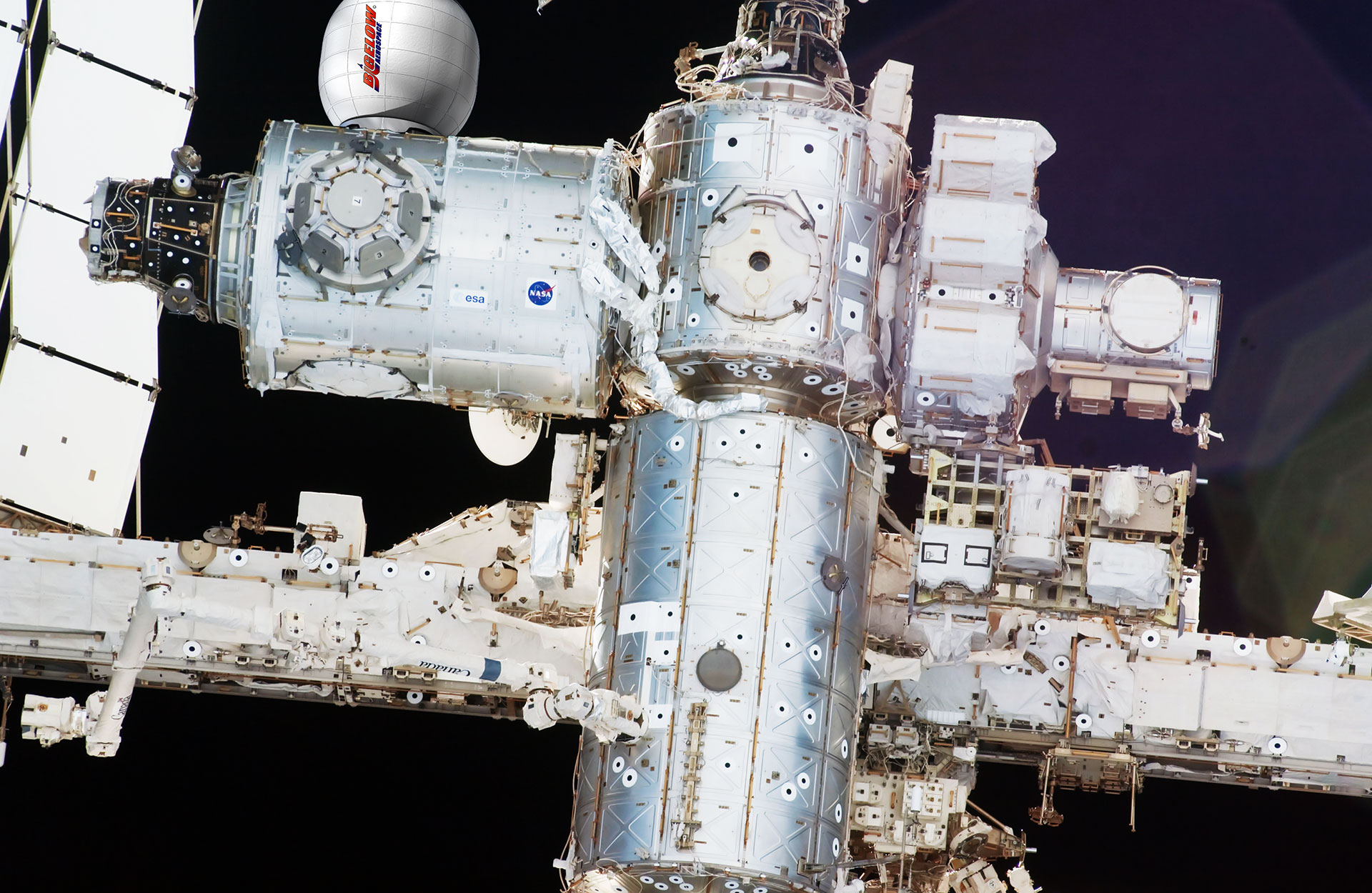
For the third time this year—following hard on the heels of January’s Jason-3 launch out of Vandenberg Air Force Base, Calif., and last month’s flight of the SES-9 communications satellite to Geostationary Transfer Orbit (GTO) from Cape Canaveral Air Force Station, Fla.—SpaceX aims to deliver another Falcon 9 booster aloft at 4:43 p.m. EDT Friday, 8 April. Carrying the CRS-8 Dragon cargo ship to the International Space Station (ISS), this mission will be conducted under the language of the $1.6 billion Commercial Resupply Services contract, signed between SpaceX and NASA back in December 2008. Due to the nature of Dragon’s destination, SpaceX will aim for an “instantaneous” launch window, with no scope to accommodate changing weather conditions or technical issues on the ground. In the event of a scrub on Friday, the countdown clock will recycle toward a backup T-0 at 4:20 p.m. EDT Saturday. This mission represents the first station-bound Dragon in almost a year, following last June’s catastrophic high-altitude failure of CRS-7, and is notable in that it will deliver the Bigelow Expandable Activity Module (BEAM) for installation onto the aft-facing port of the Tranquility node.
Originally targeted to fly last September, CRS-8—the eighth of 12 “dedicated” Dragon flights under the initial 2008 contract with NASA—encountered significant delay after the CRS-7 mishap. Following the return to flight of the Falcon 9, just before Christmas, SpaceX headed into a busy 2016 and got to work clearing a backlog of payloads for its NASA and commercial clients. With the completion of the Jason-3 and SES-9 missions, CRS-8 stands next on the list for a year which is expected to see as many as three Dragon launches. In addition to BEAM, SpaceX plans to deliver an International Docking Adapter (IDA) to support future Commercial Crew operations, as well as the Department of Defense’s Space Test Program (STP)-H5, with the Lightning Imaging Sensor (LIS), and the Stratospheric Aerosol and Gas Experiment (SAGE)-III to enhance the station’s capability as a research platform.

Liftoff of the CRS-8 mission will occur from the storied Space Launch Complex (SLC)-40 at the Cape, an old Titan III/IV pad which SpaceX leased from Air Force Space Command in April 2007. After extensive upgrades—including the installation of liquid oxygen and rocket-grade kerosene (RP-1) tankage, as well as a Horizontal Integration Facility (HIF) for booster and payload preparations—the Hawthorne, Calif.-based launch services company flew its first Falcon v1.0 in June 2010. Since then, SLC-40 has been shaken by the roar of a further 21 Falcon rockets, delivering eight Dragons, eight GTO-bound communications satellites, and a handful of payloads destined for other locations: Jason-3 and Canada’s Cascade, SmallSat and IOnospheric Polar Explorer (CASSIOPE) into polar orbit, and the Deep Space Climate Observatory (DSCOVR) to the Sun-Earth L1 Lagrange Point.
As previously outlined by AmericaSpace’s Talia Landman, BEAM was the subject of a $17.8 million contract, signed in January 2013 by NASA and Las Vegas, Nev.-based Bigelow Aerospace. The torus-shaped module will be the first inflatable pressurized module to be added to the ISS and is expected to be used as a technology demonstrator up to two years. Bigelow Aerospace—founded by Budget Suites of America hotel magnate and aerospace entrepreneur Robert Bigelow in 1998—has for almost two decades pioneered inflatable structures for scientific and commercial operations in space. BEAM, which arrived at the Kennedy Space Center (KSC) in Florida in July 2015 for final processing, has been classified as a “sub-scale demonstration” of Bigelow Aerospace’s expandable module technology.
Such structures are nothing new. Back in the mid-1990s, NASA proposed its four-level “TransHab” for the space station—a multi-layered facility, principally composed of Nextel and woven Kevlar—which might have housed a wardroom, individual crew quarters, a kitchen, and exercise suite. However, its spiraling costs caused delays and the project was eventually canceled in 2000. Had TransHab reached fruition, it would have measured 26.9 feet (8.2 meters) in diameter, far larger than the 14.4-foot (4.4-meter) diameter of the Destiny, Columbus, and Kibo pressurized modules of the station’s U.S. Orbital Segment (USOS). Bigelow later licensed the multi-layered, expandable technology from NASA and secured a trio of Space Act agreements. In 2010, the space agency expressed interest in “connecting a Bigelow expandable craft to the ISS to verify their safety by testing life-support, radiation-shielding, thermal control and communications capabilities.”
By this time, Bigelow had launched actual flight hardware into space. In July 2006, the company flew the Genesis-I experimental habitat, atop a Russian Dnepr booster, which represented a one-third-scale representation of its proposed BA-330 facility. Within just 10 minutes, a single gas tank successfully expanded Genesis-I to a length of 14.4 feet (4.4 meters) and a diameter of 8.3 feet (2.5 meters), with an internal volume of 406 cubic feet (11.5 cubic meters). Successfully weathering a major radiation event, caused by a solar storm, in December 2006, Genesis-I and its payload of photographs, toys, and cards from Bigelow employees, together with Madagascan hissing cockroaches and Mexican jumping beans, remained functional for over two years. It is still in orbit today and should not re-enter the atmosphere until later this decade. A second mission, Genesis-II, was launched by another Dnepr in June 2007, bearing more cockroaches, together with South African flat rock scorpions and seed-harvester ants, as well as an interactive “Space Bingo” game. Expanded by means of multiple gas tanks, Genesis-II also remains in orbit and achieved an internal pressure between 10.1 and 10.5 psi.
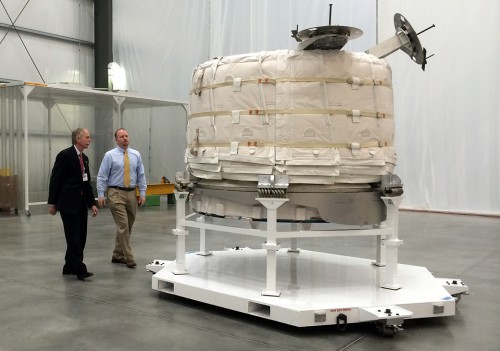
The process of preparing the hardware for the BEAM mission has been ongoing for several months and the module itself—measuring 5.7 feet (1.7 meters) long and 7.7 feet (2.4 meters) in diameter in its packaged configuration—was loaded aboard Dragon’s unpressurized “trunk” at the Cape on 24 February.
The spacecraft was then mated with the Upgraded Falcon 9, which was transferred from the HIF to the SLC-40 pad surface on Tuesday, 5 April, for a standard Static Fire Test of its nine Merlin 1D+ first-stage engines. “Static fire complete,” SpaceX tweeted late Tuesday. “Teams reviewing data in advance of Dragon mission to @Space_Station.” Following the completion of the test, the standard Launch Readiness Review (LRR) should take place during Thursday.
At about the same time, the Autonomous Spaceport Drone Ship (ASDS) departed Port of Cape Canaveral at 10:28 a.m. EDT Tuesday, with the Elsbeth III tug, bound for a position in the Atlantic Ocean to recover the Upgraded Falcon 9’s first stage. AmericaSpace’s Mike Killian previously highlighted that for the foreseeable future SpaceX will adopt a mixture of ASDS landings at sea and “land” landings at Cape Canaveral’s Landing Zone (LZ)-1, as dictated by available vehicle performance.
The spectacular success of the inaugural Upgraded Falcon 9 first stage to land on solid ground at LZ-1 in December has been tempered by mixed fortunes when attempting to land on the ASDS. A series of “controlled oceanic touchdowns” in April, July, and September 2014 were followed by four attempts to physically land on the ASDS. The first, in January 2015, saw the first stage reach the deck, but impact at a 45-degree angle and explode, whilst the second, in April 2015, landed with excessive lateral velocity and toppled over upon impact. Then, in January 2016, the final Falcon 9 v1.1 came close to a bull’s-eye landing on the ASDS, but was thwarted by the failure of one of its landing legs to properly latch into position. More recently, last month’s first-stage hardware from the SES-9 launch reached the deck—against many odds, having endured a high-energy re-entry and a truncated series of descent burns—but “impacted hard” on the ASDS and was lost. At the time, SpaceX CEO Elon Musk expressed his hope that the more benign CRS-8 launch environment may offer improved conditions for a successful ASDS landing.
Unlike the earlier Falcon 9 v1.1—which launched 15 times between September 2013 and January 2016, with a 93.3-percent success record—the Upgraded Falcon 9 follows a different fueling protocol. Whereas its predecessor required several hours for liquid oxygen and RP-1 to be loaded, the Upgraded Falcon 9 does not require tanking to commence until 35 minutes before T-0. The countdown will reach its final “Go/No-Go” polling point of all stations at T-13 minutes, after which the Terminal Countdown will get underway at T-10 minutes.
During this period, the nine Merlin 1D+ engines will be chilled, ahead of their ignition sequence. All external power utilities from the Ground Support Equipment (GSE) will be disconnected and at T-5 minutes the 90-second process of retracting the “strongback” from the vehicle will get underway. The Flight Termination System (FTS)—tasked with destroying the vehicle in the event of a major accident during ascent—will be placed onto internal power and armed. Fueling will then conclude and the first stage’s propellant tanks will attain their proper flight pressures. The Merlin 1D+ engines will be purged with gaseous nitrogen, and, at T-60 seconds, the SLC-40 complex’s “Niagara” deluge system of 53 nozzles will be activated, flooding the pad surface and flame trench with 30,000 gallons (113,500 liters) of water per minute to suppress acoustic energy radiating from the engine exhausts.
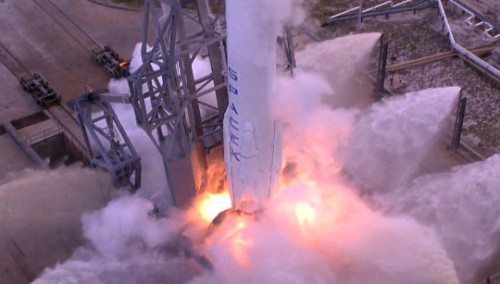
At T-3 seconds, the Merlin 1D+ engines will roar to life, ramping up to a combined thrust of 1.5 million pounds (680,000 kg). This represents a significantly enhanced propulsive yield over the 1.3 million pounds (590,000 kg) pumped out by the earlier v1.1. Following computer-commanded health checks, this will produce the correct conditions to release the stack from SLC-40. Although T-0 on Wednesday is set for 4:43 p.m. EDT, the launch window is “instantaneous,” meaning that any delay—due to adverse weather conditions or technical issues with the vehicle—will result in a scrub. A backup T-0 is available at 4:20 p.m. EDT Saturday, in the event of a delay.
Weather forecasts for Friday’s opening attempt indicate an 80-percent probability of acceptable conditions, improving to 90 percent in the event of a 24-hour scrub to Saturday. Air Force meteorologists from the 45th Weather Squadron noted an expectation of clear skies and “only a few lingering cirrostratus clouds” associated with the jetstream “digging in along the eastern seaboard.” Maximum upper-level winds will be from the west at 95 knots at 40,000 feet (12,200 meters), with “Liftoff Winds” categorized as the principal violating factor on Friday. In fact, surface winds are expected to “remain off-shore and elevated throughout the day,” gusting in the mid-20s. These surface winds will decrease to the mid-teens, and upper-level winds will decrease to about 85 knots by Saturday. However, a 24-hour scrub to the weekend is expected to see “the development of shallow coastal showers and cumulus clouds,” posing a potential violation of the Cumulus Cloud Rule. All told, this will represent a slightly improved weather outlook for Saturday.
Immediately after clearing the tower, the Upgraded Falcon 9 will execute a combined pitch, roll, and yaw program maneuver, establishing itself onto the proper flight azimuth to inject the CRS-8 Dragon into orbit. Eighty seconds into the uphill climb, the vehicle will exceed the speed of sound and experienced a period of maximum aerodynamic duress—colloquially dubbed “Max Q”—on its airframe. At about this time, the Merlin 1D+ Vacuum engine of the second stage will undergo a chill-down protocol, ahead of its own ignition later in the ascent. Later, two of the first-stage engines will throttle back, under computer command, in order to reduce the rate of acceleration at the point of Main Engine Cutoff (MECO). Finally, at T+2 minutes and 58 seconds, the seven remaining engines will shut down, and, a few seconds later, the first stage will separate from the rapidly ascending stack. The turn will then come for the restartable second stage, whose Merlin 1D+ Vacuum engine will ignite and continue the boost into orbit.
In readiness for its mission, BEAM was integrated into Dragon’s unpressurized “trunk” at the Cape on 24 February and, at 3,000 pounds (1,360 kg), represents the heaviest single cargo element transported to the space station by SpaceX to date. In its packaged configuration, it measures about 5.7 feet (1.7 meters) long and 7.7 feet (2.4 meters) in diameter and consists of a pair of metal bulkheads, an aluminum structure, and multiple fabric layers which protect an internal restraint and bladder system.
Assuming an on-time launch Friday, the CRS-8 Dragon will be grappled by means of the 57.7-foot-long (17.6-meter) Canadarm2 robotic arm at about 7 a.m. EDT. Leading the rendezvous and capture will be Britain’s Tim Peake, stationed in the multi-windowed cupola, backed-up by newly-arrived Jeff Williams. Meanwhile, Expedition 47 Commander Tim Kopra will be monitoring Common Berthing Mechanism (CBM) operations. Under the control of the Robotics Officer (ROBO) at the Mission Control Center (MCC) at the Johnson Space Center (JSC) in Houston, Texas, the visiting vehicle will be transferred to the Earth-facing (or “nadir”) port of the station’s Harmony node, with physical berthing scheduled around 10 a.m. EDT.
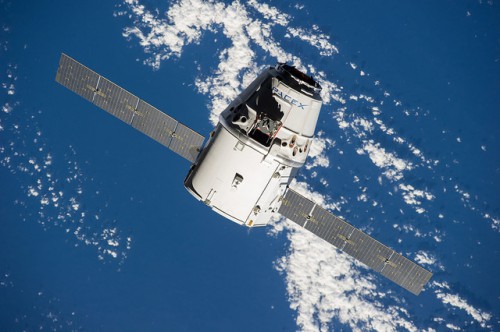
Interestingly, Dragon’s arrival will mark the first occasion that as many as six discrete visiting vehicles—piloted or unpiloted—have resided simultaneously at the ISS. In addition to the Soyuz TMA-19M and Soyuz TMA-20M spacecraft, which delivered both halves of the incumbent Expedition 47 crew to the station in December 2015 and March 2016, there are also a pair of Russian Progress resupply freighters and Orbital ATK’s newly-arrived OA-6 Cygnus cargo ship. With the arrival of Dragon, this will leave four vehicles docked at the station’s Russian Orbital Segment (ROS) and two berthed at the nadir ports of the Unity and Harmony nodes on the USOS. It will also mark the first occasion that both of NASA’s Commercial Resupply Services providers, SpaceX and Orbital ATK, are represented on-station at the same time.
Aboard Dragon’s pressurized segment are an estimated 3,628.8 pounds (1,646 kg) of cargo. These include 238 pounds (108 kg) of computer resources, 1,205 pounds (547 kg) of crew supplies, 26.4 pounds (12 kg) of EVA equipment, 674.6 pounds (306 kg) of vehicle hardware, 1,410 pounds (640 kg) of utilization hardware, and 72.7 pounds (33 kg) of Russian hardware. Yet the focus of much attention has inevitably fallen upon BEAM. The payload will be robotically removed from Dragon’s trunk, by means of the station’s 57.7-foot-long (17.6-meter) Canadarm2, on 16 April. It will be installed onto the aft-facing CBM of Tranquility, which was extensively prepared for this role by Expedition 42 spacewalker Barry “Butch” Wilmore last year.
According to NASA’s Rob Navias, the robotic removal, transfer, and installation of BEAM is “a combined ground and crew operation,” involving the ROBO controller, working hand-in-glove with Kopra, Peake, and Williams. ROBO will perform all Canadarm2 commanding, with the extraction of BEAM from Dragon’s trunk slated to begin at 2:15 a.m. EDT on 16 April and end four hours later, at about 6:15 a.m. “ROBO conducts all of the robotics,” Mr. Navias told AmericaSpace. “Crew simply monitors CBM ops at the end.”
According to Novosti Kosmonavtiki, BEAM will remain in its stowed configuration at the Tranquility aft interface until around 20 May, before it is scheduled to be expanded to its full 13-foot (4-meter) length and 10.5-foot (3.2-meter) diameter. “It takes a few weeks for the crew to outfit the vestibule between Node-3 aft port and the station,” Mr. Navias explained. “There will be leak checks and other systems checks in the interim.” All told, the expansion of BEAM—which is tentatively targeted at some stage during a two-week period, ending 2 June—is expected to require about two ISS “day” orbital passes and will be overseen by the Operations Support Officer (OSO) in Mission Control. The OSO console fulfills logistical support functions pertaining to on-orbit maintenance, together with mechanical systems, including the installation of new modules and truss components.
When fully expanded into its torus-like form, BEAM will measure about 13 feet (4 meters) in length and 10.5 feet (3.2 meters) in diameter, offering a habitable internal volume of 565 cubic feet (16 cubic meters). “Ingress does not occur until a week after expansion,” Mr. Navias added, making it increasingly likely that BEAM will not receive its first on-orbit human visitors until virtually the end of Expedition 47. Kopra, Peake, and Malenchenko are currently slated to return to Earth aboard Soyuz TMA-19M on 5 June.
Want to keep up-to-date with all things space? Be sure to “Like” AmericaSpace on Facebook and follow us on Twitter: @AmericaSpace
Missions » ISS » Missions » ISS » COTS » Missions » ISS » COTS » CRS-8 »



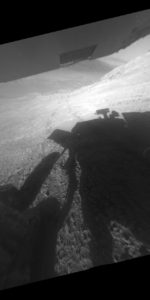
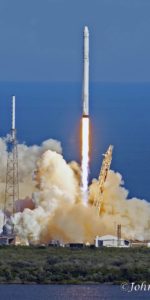
A party balloon launched on a hobby rocket and nothing more.
This is great!!
good one